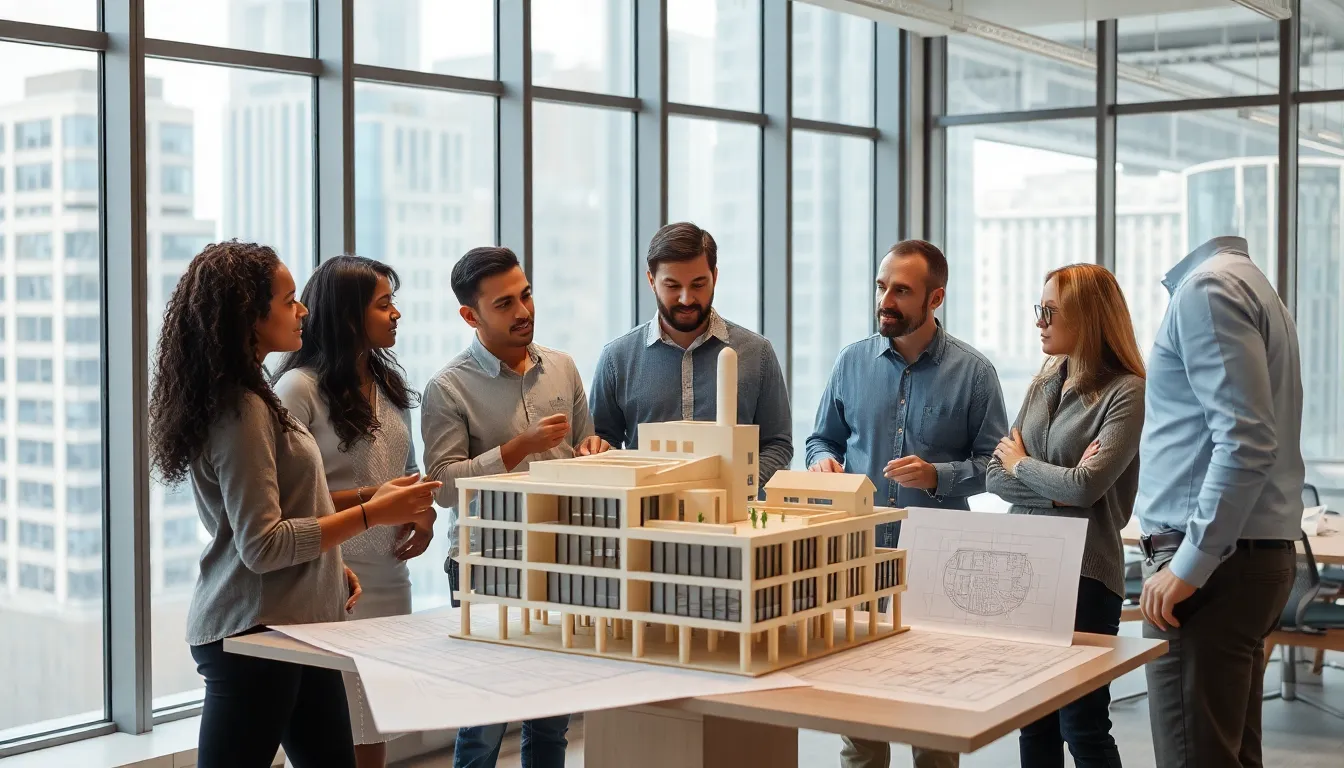Table of Contents
ToggleArchitecture isn’t just about building structures; it’s about crafting experiences that resonate. Imagine walking into a space that feels like a warm hug or a towering masterpiece that leaves you breathless. Architecture case studies dive into these captivating stories, revealing the thought processes, challenges, and triumphs behind stunning designs.
Overview of Architecture Case Studies
Architecture case studies provide in-depth insights into the intricacies of design challenges and solutions. They typically include detailed examinations of specific projects, focusing on the unique context and objectives. Each study reveals the relationship between a building’s function and its form, highlighting key decisions made during the design process.
Case studies often showcase various architectural styles, materials, and technologies. These examples illustrate how architects adapt to site conditions and user needs while maintaining aesthetic appeal. By analyzing successful projects, professionals glean valuable lessons about innovative problem-solving approaches.
Designers gain practical understanding from reviewing case studies. Insights into budget management, sustainability practices, and community impact emerge from these analyses. Furthermore, case studies assist in identifying best practices in project management and client engagement.
Architectural education benefits significantly from case studies. Students can observe real-world applications of theoretical principles, which aids in developing critical thinking skills. Effective case studies serve as a bridge between academic learning and professional practice, preparing students for challenges in the field.
Collaboration often appears as a theme in architecture case studies. Architects, engineers, and clients contribute diverse perspectives, leading to well-rounded outcomes. Documenting these collaborative efforts emphasizes the importance of teamwork in achieving successful design solutions.
Overall, architecture case studies represent a vital resource for those seeking to understand the complexities behind noteworthy structures. They serve not only as educational tools but also as a source of inspiration for future projects in the architectural community.
Importance of Case Studies in Architecture

Architecture case studies provide essential insights into the design process, enabling a deeper appreciation of architectural complexities. They serve as a bridge between theory and practice, allowing professionals and students to explore successful projects firsthand.
Enhancing Design Understanding
Insights from case studies illuminate design principles and methodologies. Professionals analyze various architectural elements, learning how aesthetics, functionality, and context interrelate. Each study reveals unique challenges faced during the project’s lifecycle, offering concrete examples of how to overcome obstacles. By examining different architectural styles and materials, architects gain inspiration for innovative solutions and creative designs. Understanding these nuances fosters a refined approach to future projects, shaping a more nuanced perspective on architectural expression.
Learning from Real-World Applications
Real-world applications underscore the importance of adaptability in architecture. Evidence from successful case studies highlights problem-solving strategies utilized in diverse environments. Architectural teams learn how to balance client needs, environmental considerations, and budget constraints. Each project showcases tailored solutions that address specific requirements while maximizing overall impact. Observing these applications in action informs better decision-making and strengthens skills in project management. Challenges faced and resolved in these studies cultivate resilience and creativity in design thinking, directly influencing the development of future architectural endeavors.
Types of Architecture Case Studies
Architecture case studies can be categorized into two main types: historical and contemporary. Each type offers unique insights into the evolution of design practices and the impact of context on architectural solutions.
Historical Case Studies
Historical case studies explore past architectural projects, providing a perspective on design trends and societal influences. These analyses focus on structures that shaped architectural history. By examining iconic buildings and their contexts, insights into material choices, construction methods, and cultural narratives emerge. For instance, the Parthenon in Athens exemplifies ancient Greek ideals of beauty and democracy. Students and professionals learn how historical significance affects current practices and informs contemporary design. Studying these projects reveals adaptive reuse practices and how modern architects honor historical contexts.
Contemporary Case Studies
Contemporary case studies highlight recent architectural projects, showcasing modern design challenges and solutions. These examples emphasize innovation in response to evolving needs and environmental concerns. The High Line in New York City serves as a model for urban renewal, transforming an abandoned rail line into a vibrant public space. During the analysis, architects explore sustainable materials and community engagement strategies. Each project serves as a learning tool, revealing practical applications of contemporary architectural theory. Understanding these cases fosters a discussion on future trends and the role of technology in shaping spaces.
Analyzing Successful Architecture Case Studies
Successful architecture case studies illustrate essential components that contribute to remarkable designs. They offer insights into how design intent aligns with user experience. Collaboration among multidisciplinary teams enhances creativity and problem-solving. Attention to detail and sustainability practices often lead to innovative outcomes. Effective communication with clients ensures alignment with their vision. The integration of materials and technologies plays a significant role in achieving functionality and aesthetics. Each case study serves as a reference point for future projects, reflecting lessons learned from both successes and setbacks.
Key Elements of Success
Successful architecture relies on several key elements. A clear vision guides the design process from inception to completion. Effective collaboration among architects, engineers, and clients facilitates problem-solving and creativity. The adaptability to site conditions often influences design outcomes. Sustainable practices enhance environmental impact and resource management. Engaging with the community ensures that the project meets the needs of its users. Each of these elements contributes to the overall success of architectural projects.
Lessons Learned from Failures
Failures in architecture provide valuable lessons. Analyzing these setbacks often highlights the importance of thorough planning and research. Misalignment between client expectations and design outcomes can lead to significant challenges. Ignoring site-specific conditions often results in functional issues. Additionally, underestimating budget constraints can derail a project. Each failure offers insights into avoiding similar mistakes in future designs. Embracing lessons from these experiences fosters resilience and encourages innovation within the architectural field.
Tools and Methods for Conducting Case Studies
Various tools and methods support the successful execution of architecture case studies. Data collection stands as a fundamental task, utilizing surveys, interviews, and field observations to gather insights from stakeholders. Digital tools like AutoCAD and Revit facilitate precise modeling, allowing architects to visualize design proposals and revisions effectively.
Case analysis involves examining project documentation such as architectural drawings, budget reports, and timelines. This information helps identify critical challenges and solutions. Research methods, including comparative analysis, allow professionals to assess similar projects, enhancing the learning process through diverse contexts.
Collaboration tools play a significant role in maintaining open communication among team members. Platforms like Slack and Trello enable real-time updates and task management. Group discussions often yield valuable perspectives, promoting innovative ideas and fostering a deeper understanding of design intent.
Stakeholder engagement remains central to the case study process. Feedback sessions with clients and users provide critical insights that could shape future designs. These interactions lead to a more user-centered approach, enhancing overall project efficacy.
Visual presentation methods, including infographics and video documentation, effectively convey complex concepts. Architects often rely on these methods to engage broader audiences and communicate findings more compellingly. Presenting case studies both visually and verbally adds a layer of depth to understanding architectural implications.
Finally, integrating sustainability practices into case studies has become vital. Evaluating the environmental impact of design choices encourages architects to prioritize eco-friendly materials and energy-efficient solutions. By utilizing these tools and methods, professionals can create comprehensive case studies that inform future architectural endeavors, bridging the gap between theory and practice.
Architecture case studies are invaluable resources that illuminate the intricate relationship between design and functionality. They provide a platform for architects to explore innovative solutions while reflecting on past successes and failures. By studying these cases, professionals gain critical insights that enhance their design thinking and problem-solving abilities.
The lessons drawn from both historical and contemporary projects foster a deeper understanding of architectural principles and methodologies. This knowledge not only inspires future designs but also encourages collaboration among multidisciplinary teams. Ultimately, architecture case studies serve as a bridge between theory and practice, shaping the future of the built environment through informed decision-making and creative exploration.







